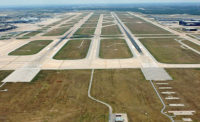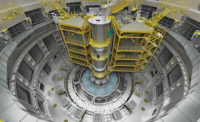Hollywood Park, a nearly 300-acre sports and entertainment district in Inglewood, Calif., being developed by Los Angeles Rams owner and chairman Stan Kroenke, now has a digital twin of its biggest venue, the $5.5-billion SoFi Stadium. As home of both the Rams and the Chargers, it's the first NFL stadium that has a digital twin being used for operations, maintenance and building efficiency.
"The idea of creating a digital twin for this project is something we hatched a few years ago," says Skarpi Hedinsson, CTO of SoFi Stadium and Hollywood Park, who worked with software developer Willow on the digital twin. "We hooked up with Willow pretty early in the process. We really partnered extremely closely with them on implementation and creation of it as we went through the construction process. Having a 3D representation of the built world, we thought would have sort of an immediate, positive impact, especially for this project which is 3.1 million sq ft."
Willow’s digital twin, Hedinsson says, enabled stadium management to analyze real-time big data across the lifecycle of the project, including development, construction and ongoing operations. While the 70,000-seat stadium hasn't been able to allow in spectators for its events yet due to the COVID-19 pandemic, stadium management have been able to use the data for building operations to optimize its mechanical operations, air conditioning, lighting and other aspects of the game day experience for players and staff on the field during games.
Part of Willow's task was to consolidate all of the systems in the massive project into something usable for stadium management.
"So, as we got into these really dense rooms, like intermediate distribution frame closets and electrical rooms and everything, a lot of those things were planned ahead of time," says Shaun Klann, president and co-founder of Willow. "We have about 1,700 different types of [building information] models making up a part of the digital twin."
The Willow team has layered the various models and their parametric information into a federated digital twin model housed on SoFi Stadium's servers. Users can peel away or dig into the details from all the data from Willow's application and the whole model can be viewed on an iPad or other tablet.
Klann says there are more than 136,000 individual assets within the SoFi Stadium digital twin. Each asset has a number of different attributes associated with it, so there are almost 1.8 million attributes within the digital twin curated from the various BIM models that were used to build it by joint venture contractor Turner/AECOM, design architect HKS, engineer Walter P Moore and the various subcontractors on the project. Klann says nearly 1,400 of the 1,700 models that make up the digital twin came from trade contractors.
"It's a really interesting thing to look at from large-scale construction standpoint as to the handover of information and when that should happen. The GC and the subs have all of this information and were curating all of this in real time," Klann says.
Hedinsson says information was taken from Procore, BIM authoring platforms and other construction management tools and put into Willow's hands and, ultimately, into the digital twin. He is hopeful that the intermediate step of curating the information—as Willow has done—will one day be unnecessary and a seamless transfer will bring the data from design and construction to operations and maintenance. Hedinsson also said they were happy with storing the information securely and satisfied it was structured in a way that was, today, difficult to hack.
"I'm not an engineer or construction guy. I'm used to building digital apps and guest experiences for Disney," says Hedinsson, who worked for 15 years for Disney and its properties ABC and ESPN before joining SoFi Stadium and Hollywood Park as its CTO. "That was always the thing that stuck out with me for Willow, it was a very visual company. Whether it's their docs, the GUI for their application or how they communicate, it's a big part of their DNA, making the presentation of all that data accessible."
Klann says that Willow's team was able to distill the 1,700 BIM models and other building information down to roughly 16GB of model data and connect it to the 1.7 million attributes identified as necessary for the digital twin.
"That data is structured from a graphical and relationship standpoint to be easy to thumb through and pull up," Klann says. "The value to the supply chain, the value to the contractor is still there. I think when we often get engaged in a project it's the contractor's first digital twin, and it's natural to have a little bit of reluctance because it represents a change to the work. What we've seen is that after the first one is done, when it comes out as the contractor's business as usual...that event became a catalyst for them to update their internal workflows."






Post a comment to this article
Report Abusive Comment